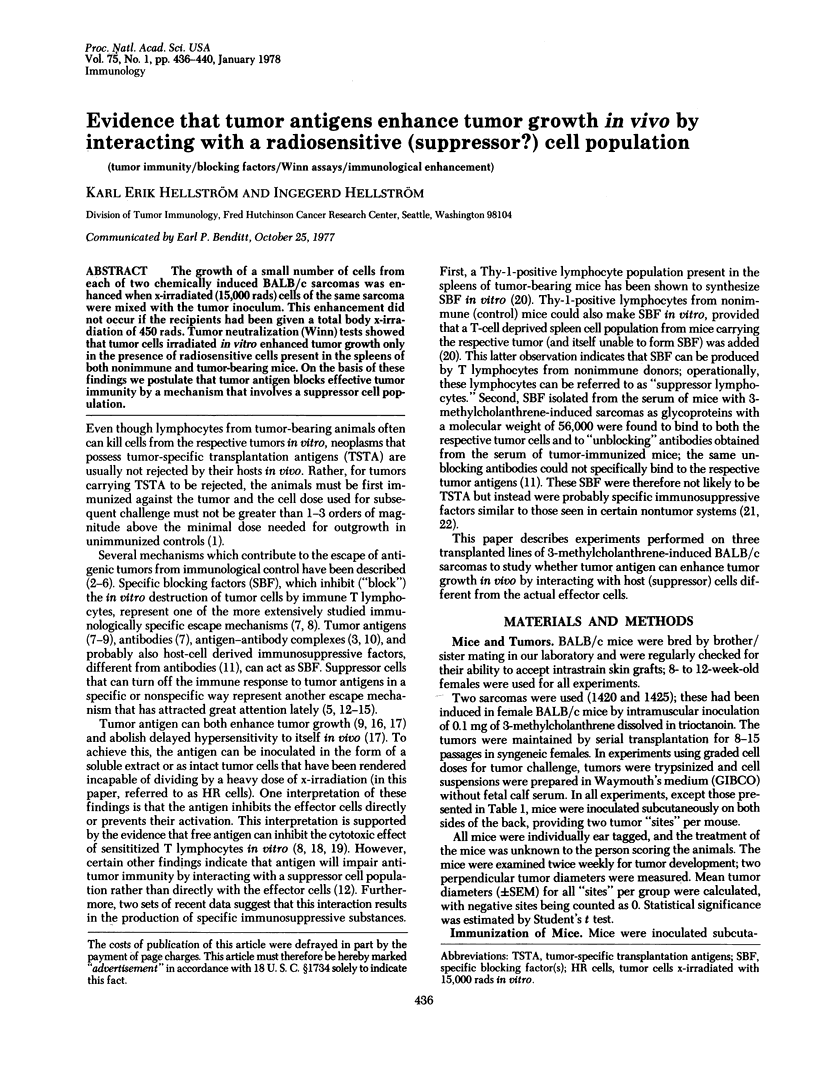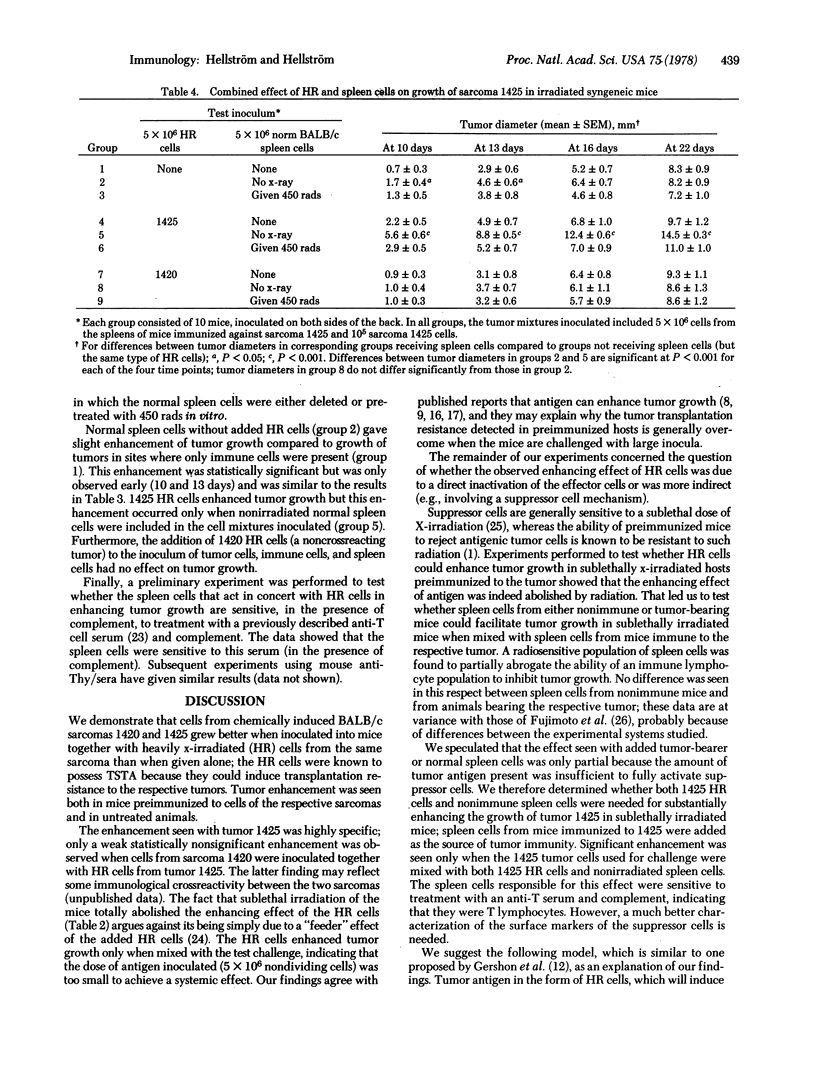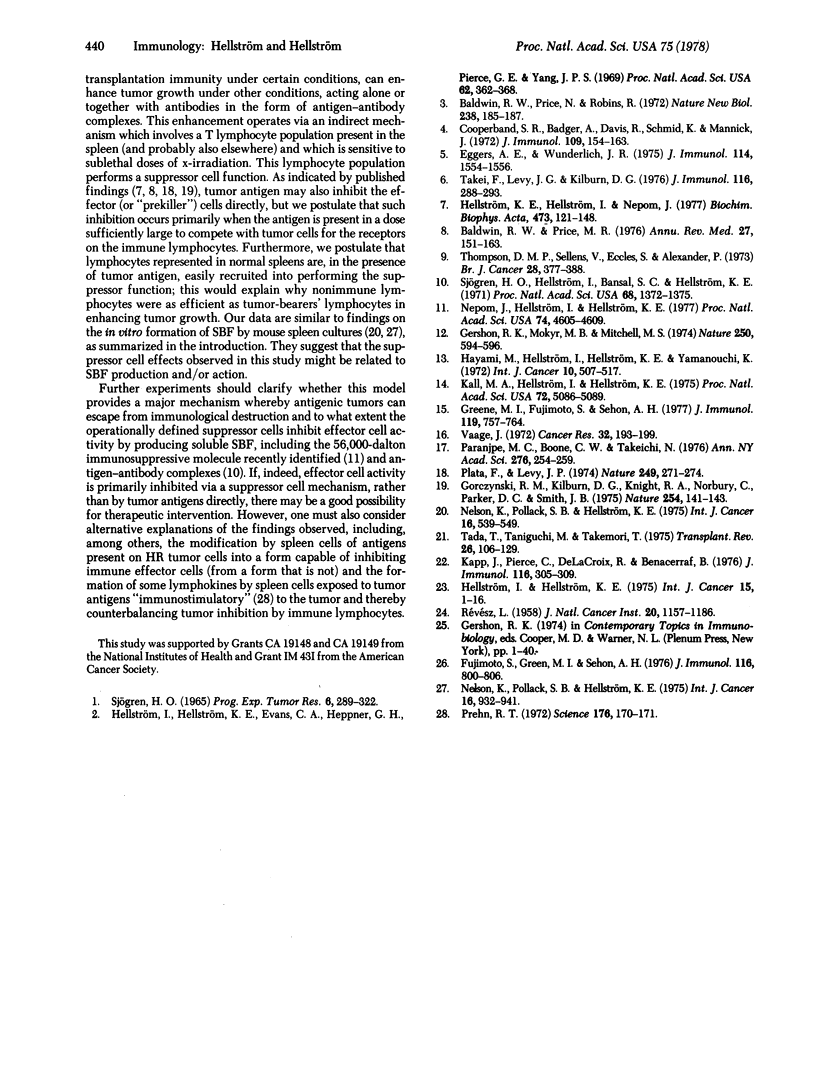Abstract
The growth of a small number of cells from each of two chemically induced BALB/c sarcomas was enhanced when x-irradiated (15,000 rads) cells of the same sarcoma were mixed with the tumor inoculum. This enhancement did not occur if the recipients had been given a total body x-irradiation of 450 rads. Tumor neutralization (Winn) tests showed that tumor cells irradiated in vitro enhanced tumor growth only in the presence of radiosensitive cells present in the spleens of both nonimmune and tumor-bearing mice. On the basis of these findings we postulate that tumor antigen blocks effective tumor immunity by a mechanism that involves a suppressor cell population.
Full text
PDF




Selected References
These references are in PubMed. This may not be the complete list of references from this article.
- Baldwin R. W., Price M. R., Robins R. A. Blocking of lymphocyte-mediated cytotoxicity for rat hepatoma cells by tumour-specific antigen-antibody complexes. Nat New Biol. 1972 Aug 9;238(84):185–186. doi: 10.1038/newbio238185a0. [DOI] [PubMed] [Google Scholar]
- Baldwin R. W., Price M. R. Tumor antigens and tumor-host relationships. Annu Rev Med. 1976;27:151–163. doi: 10.1146/annurev.me.27.020176.001055. [DOI] [PubMed] [Google Scholar]
- Cooperband S. R., Badger A. M., Davis R. C., Schmid K., Mannick J. A. The effect of immunoregulatory globulin (IRA) upon lymphocytes in vitro. J Immunol. 1972 Jul;109(1):154–163. [PubMed] [Google Scholar]
- Eggers A. E., Wunderlich J. R. Suppressor cells in tumor-bearing mice capable of nonspecific blocking of in vitro immunization against transplant antigens. J Immunol. 1975 May;114(5):1554–1556. [PubMed] [Google Scholar]
- Fujimoto S., Greene M. I., Sehon A. H. Regulation of the immune response to tumor antigens. II. The nature of immunosuppressor cells in tumor-bearing hosts. J Immunol. 1976 Mar;116(3):800–806. [PubMed] [Google Scholar]
- Gershon R. K., Mokyr M. B., Mitchell M. S. Activation of suppressor T cells by tumour cells and specific antibody. Nature. 1974 Aug 16;250(467):594–596. doi: 10.1038/250594a0. [DOI] [PubMed] [Google Scholar]
- Gorczynski R. M., Kilburn D. G., Knight R. A., Norbury C., Parker D. C., Smith J. B. Nonspecific and specific immunosuppression in tumour-bearing mice by soluble immune complexes. Nature. 1975 Mar 13;254(5496):141–143. doi: 10.1038/254141a0. [DOI] [PubMed] [Google Scholar]
- Greene M. I., Fujimoto S., Sehon A. H. Regulation of the immune response to tumor antigens. III. Characterization of thymic suppressor factor(s) produced by tumor-bearing hosts. J Immunol. 1977 Aug;119(2):757–764. [PubMed] [Google Scholar]
- Hayami M., Hellström I., Hellström K. E., Yamanouchi K. Cell-mediated destruction of Rous sarcomas in Japanese quails. Int J Cancer. 1972 Nov;10(3):507–517. doi: 10.1002/ijc.2910100309. [DOI] [PubMed] [Google Scholar]
- Hellström I., Hellström K. E., Evans C. A., Heppner G. H., Pierce G. E., Yang J. P. Serum-mediated protection of neoplastic cells from inhibition by lymphocytes immune to their tumor-specific antigens. Proc Natl Acad Sci U S A. 1969 Feb;62(2):362–368. doi: 10.1073/pnas.62.2.362. [DOI] [PMC free article] [PubMed] [Google Scholar]
- Hellström K. E., Hellström I., Nepom J. T. Specific blocking factors--are they important? Biochim Biophys Acta. 1977 Dec 23;473(2):121–148. doi: 10.1016/0304-419x(77)90003-8. [DOI] [PubMed] [Google Scholar]
- Kall M. A., Hellström I., Hellström K. E. Different responses of lymphoid cells from tumor-bearing as compared to tumor-immunized mice when sensitized to tumor specific antigens in vitro. Proc Natl Acad Sci U S A. 1975 Dec;72(12):5086–5089. doi: 10.1073/pnas.72.12.5086. [DOI] [PMC free article] [PubMed] [Google Scholar]
- Kapp J. A., Pierce C. W., De la Croix F., Benacerraf B. Immunosuppressive factor(s) extracted from lymphoid cells of nonresponder mice primed with L-glutamic acid60-L-alanine30-L-tyrosine10 (GAT). J Immunol. 1976 Feb;116(2):305–309. [PubMed] [Google Scholar]
- Nelson K., Pollack S. B., Hellström K. E. In vitro synthesis of tumor-specific factors with blocking and antibody-dependent cellular cytotoxicity (ADC) activities. Int J Cancer. 1975 Dec 15;16(6):932–941. doi: 10.1002/ijc.2910160607. [DOI] [PubMed] [Google Scholar]
- Nelson K., Pollack S. B., Hellström K. E. Specific anti-tumor responses of cultured immune spleen cells III. Further characterization of cells which synthesize factors with blocking and antiserum-dependent cellular cytotoxic (ADC) activities. Int J Cancer. 1975 Oct 15;16(4):539–549. doi: 10.1002/ijc.2910160404. [DOI] [PubMed] [Google Scholar]
- Nepom J. T., Hellström I., Hellström K. E. Antigen-specific purification of blocking factors from sera of mice with chemically induced tumors. Proc Natl Acad Sci U S A. 1977 Oct;74(10):4605–4609. doi: 10.1073/pnas.74.10.4605. [DOI] [PMC free article] [PubMed] [Google Scholar]
- Paranjpe M. S., Boone C. W., Takeichi N. Discussion paper: specific paralysis of the antitumor cellular immune response produced by growing tumors studied with a radioisotope footpad assay. Ann N Y Acad Sci. 1976;276:254–259. doi: 10.1111/j.1749-6632.1976.tb41651.x. [DOI] [PubMed] [Google Scholar]
- Plata F., Levy J. P. Blocking of syngeneic effector T cells by soluble tumour antigens. Nature. 1974 May 17;249(454):271–274. doi: 10.1038/249271a0. [DOI] [PubMed] [Google Scholar]
- Prehn R. T. The immune reaction as a stimulator of tumor growth. Science. 1972 Apr 14;176(4031):170–171. doi: 10.1126/science.176.4031.170. [DOI] [PubMed] [Google Scholar]
- REVESZ L. Effect of lethally damaged tumor cells upon the development of admixed viable cells. J Natl Cancer Inst. 1958 Jun;20(6):1157–1186. [PubMed] [Google Scholar]
- Sjögren H. O., Hellström I., Bansal S. C., Hellström K. E. Suggestive evidence that the "blocking antibodies" of tumor-bearing individuals may be antigen--antibody complexes. Proc Natl Acad Sci U S A. 1971 Jun;68(6):1372–1375. doi: 10.1073/pnas.68.6.1372. [DOI] [PMC free article] [PubMed] [Google Scholar]
- Sjögren H. O. Transplantation methods as a tool for detection of tumor-specific antigens. Prog Exp Tumor Res. 1965;6:289–322. [PubMed] [Google Scholar]
- Tada T., Taniguchi M., Takemori T. Properties of primed suppressor T cells and their products. Transplant Rev. 1975;26:106–129. doi: 10.1111/j.1600-065x.1975.tb00177.x. [DOI] [PubMed] [Google Scholar]
- Takei F., Levy J. G., Kilburn D. G. In vitro induction of cytotoxicity against syngeneic mastocytoma and its suppression by spleen and thymus cells from tumor-bearing mice. J Immunol. 1976 Feb;116(2):288–293. [PubMed] [Google Scholar]
- Thomson D. M., Sellens V., Eccles S., Alexander P. Radioimmunoassay of tumour specific transplantation antigen of a chemically induced rat sarcoma: circulating soluble tumour antigen in tumour bearers. Br J Cancer. 1973 Nov;28(5):377–388. doi: 10.1038/bjc.1973.163. [DOI] [PMC free article] [PubMed] [Google Scholar]
- Vaage J. Specific desensitization of resistance against a syngeneic methylcholanthrene-induced sarcoma in C3Hf mice. Cancer Res. 1972 Feb;32(2):193–199. [PubMed] [Google Scholar]


